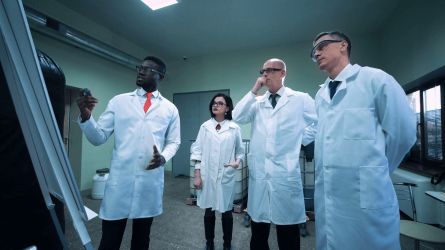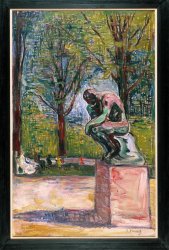- Sep 22, 2013
- 4,956
- 250
- 85
Can psychology help us in determining contours of social norms and expected behaviors regarding the relations between races in a pluralistic nation such as America?
This thought-model was inspired by Trading Places.
What do you think?
====
Imagine that a racist black man named John (an African-American who has a biased and negative attitude towards Caucasians) and a racist white man named Hal (a Caucasian who believes African-Americans are inferior) both stare at a green-colored patch/swatch in a hypothetical lab experiment about perception and sociology/race. John and Hal do not like each other (obviously) but they tell the psychologist running the experiment that they both agree that they both see a green-colored patch/swatch; the psychologist then confirms that neither John nor Hal are color-blind.

The psychologist asks John and Hal to evaluate why they think they agreed about both seeing the color green even though they do not necessarily agree about other things, and John and Hal humbly admit that they agreed about both seeing a green-colored patch/swatch, since neither is color-blind. The psychologist then tells them that they will now work a similar experiment with a color-blind person/subject and then see how much they agree and what they agree about. John and Hal immediately wonder if they would agree about anything with each other besides color (since both men are biased/racist towards each other!).

When John and Hal are introduced to a color-blind person/subject (an Asian man named James who is not racist), they run the experiment the psychologist presents to the three of them. Once again, John and Hal agree they see green, while James (since he is color-blind) does not see green. John and Hal confirm that they agree that the two of them saw green but they disagree about why James *thinks* he didn't see green. The psychologist suggests to John and Hal that since they themselves were biased against each other (because of racial backgrounds), they hesitated in agreeing about color-matching more than necessary (since, of course, color-perception in color-blind people is a very hairy and complicated issue). John and Hal realize that they were willing to agree *minimally* about a very *basic* perception experiment about color-perception but were not willing to continue *speculating* about what they thought of other people (who may or may not be color-blind).

In other words, this simple experiment reveals that there are delicate psycho-sociological contours that construct basic agreements between otherwise racially-biased people while not necessarily catalyzing continued/deeper discussions about similarities between 'different' people (i.e., people of different ethnic backgrounds, people with differing abilities in perceiving colors). This sort of *rudimentary* groundwork 'tabula-rasa' thought-model (or hypothetical experiment) suggests that how we construct images of people around us is based in great deal on the levels of labor and expectation. That sounds normal enough --- when we're emotionally fatigued or think too much is expected of us, we may not 'extend' ourselves to make optimistic friendship/trust-bonds. Therefore, much of race-relations (in America especially arguably --- the land of pluralism and media) may be greatly based on SOCIAL EXPECTATIONS! This suggests, of course, that the role of journalism is great in the era of multiculturalism.
====

This thought-model was inspired by Trading Places.
What do you think?
====
Imagine that a racist black man named John (an African-American who has a biased and negative attitude towards Caucasians) and a racist white man named Hal (a Caucasian who believes African-Americans are inferior) both stare at a green-colored patch/swatch in a hypothetical lab experiment about perception and sociology/race. John and Hal do not like each other (obviously) but they tell the psychologist running the experiment that they both agree that they both see a green-colored patch/swatch; the psychologist then confirms that neither John nor Hal are color-blind.

The psychologist asks John and Hal to evaluate why they think they agreed about both seeing the color green even though they do not necessarily agree about other things, and John and Hal humbly admit that they agreed about both seeing a green-colored patch/swatch, since neither is color-blind. The psychologist then tells them that they will now work a similar experiment with a color-blind person/subject and then see how much they agree and what they agree about. John and Hal immediately wonder if they would agree about anything with each other besides color (since both men are biased/racist towards each other!).

When John and Hal are introduced to a color-blind person/subject (an Asian man named James who is not racist), they run the experiment the psychologist presents to the three of them. Once again, John and Hal agree they see green, while James (since he is color-blind) does not see green. John and Hal confirm that they agree that the two of them saw green but they disagree about why James *thinks* he didn't see green. The psychologist suggests to John and Hal that since they themselves were biased against each other (because of racial backgrounds), they hesitated in agreeing about color-matching more than necessary (since, of course, color-perception in color-blind people is a very hairy and complicated issue). John and Hal realize that they were willing to agree *minimally* about a very *basic* perception experiment about color-perception but were not willing to continue *speculating* about what they thought of other people (who may or may not be color-blind).

In other words, this simple experiment reveals that there are delicate psycho-sociological contours that construct basic agreements between otherwise racially-biased people while not necessarily catalyzing continued/deeper discussions about similarities between 'different' people (i.e., people of different ethnic backgrounds, people with differing abilities in perceiving colors). This sort of *rudimentary* groundwork 'tabula-rasa' thought-model (or hypothetical experiment) suggests that how we construct images of people around us is based in great deal on the levels of labor and expectation. That sounds normal enough --- when we're emotionally fatigued or think too much is expected of us, we may not 'extend' ourselves to make optimistic friendship/trust-bonds. Therefore, much of race-relations (in America especially arguably --- the land of pluralism and media) may be greatly based on SOCIAL EXPECTATIONS! This suggests, of course, that the role of journalism is great in the era of multiculturalism.
====

